 Do you want to create your own deep sub bass sound on any synthesizer?
Do you want to create your own deep sub bass sound on any synthesizer?
It is in fact one of the easiest sounds to create, and if you do it correctly you will also save a lot of precious CPU power on your computer.
Let’s go through how to sound design a sub bass, step by step.
1 – Sine Wave or Triangle Wave
Start by using only one oscillator on your synthesizer, and set it to a sine wave. A sub bass is all about perfect clarity, tightness and control in the low end frequencies. And the most fundamental wave form that can handle the lowest frequencies without suffering, is a warm round sine wave. This is a pure fundamental without any harmonic overtones. If the synthesizer your choose does not have a sine wave to use in the oscillator, the second choice is a triangle wave.
2 – Warm Low Pass Filter
If you used a pure sine wave this step might be unnecessary, but I usually do it anyway. And that is to add a low pass filter, set it to around 80Hz, and the resonance to 0. This step is simply to make sure no frequencies above the low deep bass end is present in your sub bass sound.
3 – Smooth out the Envelopes
Sometimes you can hear short click type sounds when you play your sub bass sound. To avoid this, and make it even smoother, you just have to add a tiny amount of Attack Time and Release Time in your Amp Envelope. I usually start around 10ms attack, and 20-30ms release. The decay and sustain times are more open to how you like to set them, but I usually set them to the max to make sure the sub bass does not loose power and energy on long sustained notes.
4 – Add Saturation for Harmonics
If you want to add some more presence in your deep sub bass, I recommend adding a saturation or distortion effect on the output. It is best if you have a saturation effect that you can set to “leave the low end intact”, so that your lowest frequencies are still crystal clear.
5 – Layer with other Bass Sounds
In most cases you want to add more presence, attack and body to your final bass sound. The sub bass you just created is mainly there to take care of that extreme low end range, with perfect clarity and control. Whatever you layer your sub bass with, I recommend making it on its own track in your project. Meaning another track with an electric bass, orchestral strings bass, low pad, or perhaps edgy synth bass.
